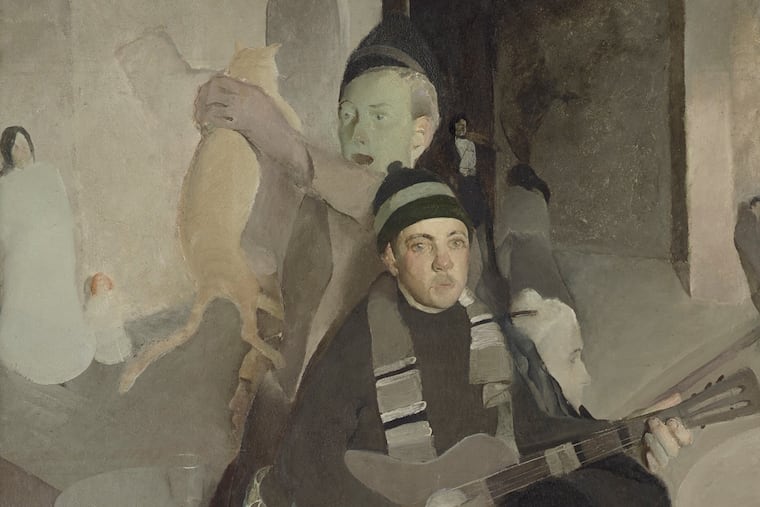What to see in Philly galleries this January
The moody Edwin Walter Dickinson, inflatable ‘Janis Project’ works, winter whites

When the weather is temperamental and gray, my thoughts turn to artists who’ve conveyed dark moods and melancholy.
One master of gloom was Edwin Walter Dickinson (1891-1978), the esteemed American “painter’s painter” of dreamlike landscapes, symbolic still lifes, and strange, occasionally macabre, interior scenes of figures enacting curious scenes in dim rooms. He is the main subject of a beautiful, under-the-radar exhibition at the Philadelphia Museum of Art.
“Between Nature and Abstraction: Edwin Dickinson and Friends,” tucked away in Gallery 119 of the museum’s American art wing, marks the museum’s first display of six Dickinson paintings that were a part of a recent bequest from the late collector Daniel W. Dietrich II.
Also included in the exhibition are three Dickinsons already in the museum’s collection, as well as paintings by two of Dickinson’s instructors, William Merritt Chase and Charles Webster Hawthorne. Here, too, are brooding paintings by Albert Pinkham Ryder, with whom Dickinson is often compared, and works by contemporaries including Willem de Kooning, Edward Hopper, Charles Demuth, Rockwell Kent, Milton Avery, and Jack Tworkov.
All are from the museum’s collection and were chosen by its senior curator of American art, Kathleen A. Foster.
The somberness of Dickinson’s palette and his eerie images are understandable. Born in Seneca Falls, N.Y., and raised in nearby Buffalo, Dickinson lost his mother to tuberculosis in 1903, when he was 12. One of his brothers committed suicide in 1913 by jumping from Dickinson’s sixth-floor apartment window in Manhattan, where the artist had moved to study painting with Chase. Another brother was murdered in Detroit in 1935.
Interior (1916), the first of eight monumental figure paintings that established his reputation, is a haunting image of odd characters clustered around a young man playing a guitar who seems oblivious to them. Locals from Provincetown, Mass., where Dickinson lived during his 20s and 30s, served as models.
One of Dickinson’s signature ways of painting — known as “premier coup” or “first strike” and championed by Chase — was to apply paint quickly to a surface with a brush, palette knife, and his fingers. Its blurred effect is seen in this exhibition in such paintings as Apple Tree with Mistletoe (1938) and East Room (1940).
Another technique of his, borrowed from Paul Cézanne, was to create forms with patches of closely related colors, as in Glen Eyrie (1929), an interior view of a cottage his family owned. Seen up close, it looks completely abstract.
The late Philadelphia artist Thomas Chimes was three decades younger than Dickinson. In his mysterious 1988 painting Faustroll (L’Infini), a man in a hat is seen in profile as through a dense mist. It makes a logical bookend to the show.
Through Feb. 10, Philadelphia Museum of Art, 2600 Benjamin Franklin Parkway, 10 a.m. to 5 p.m. Tuesdays through Sundays (Wednesdays and Fridays to 8:45 p.m.). 215-763-8100 or philamuseum.org.
A “Janis” homecoming
Frank Hyder, who used to run the Projects Gallery in Northern Liberties and is now based in Miami, is the artist behind the Janis Project, a series of enormous inflatable heads that have been exhibited around the world, from Ho Chi Minh City to the Panama Canal.
Named after the Roman god Janus, the series is also inspired by Easter Island’s Moai statues and by the colossal Olmec heads of Mexico.
An assortment of Hyder’s inflated heads and affiliated Janis Project watercolors have been on display since November at the Michener Art Museum in Doylestown (through March 10). And through Jan. 19 you can also see some at the James Oliver Gallery in Center City.
Are you wondering how an 8-foot-high inflatable head might look in your place? They look splendid and regal in Oliver’s all-white loft space.
Through Jan. 19, James Oliver Gallery, 723 Chestnut St., 5 to 8 p.m. Wednesdays through Fridays, noon to 8 p.m. Saturdays, and by appointment. 267-918-7432 or jamesolivergallery.com.
Winter whites
Melissa Maddonni Haims is a Philadelphia artist known for her knitted artworks, and an independent curator. In 2017, she organized the Achromatic group show at Mount Airy Contemporary of predominantly white works by textile-oriented artists.
A new, larger Achromatic has now taken over the Crawford Gallery at Springside Chestnut Hill Academy, in the original Chestnut Hill Academy building. This iteration, with works by 11 female artists, shows equal measures of aplomb and hygge. It’s another winter treat.
Through Feb. 1 at Crawford Gallery, Springside Chestnut Hill Academy, 500 W. Willow Grove Ave. (across from the playing fields), 8 a.m. to 4 p.m. Mondays through Fridays and by appointment. Details at 215-327-5747 or the SCH Facebook page.